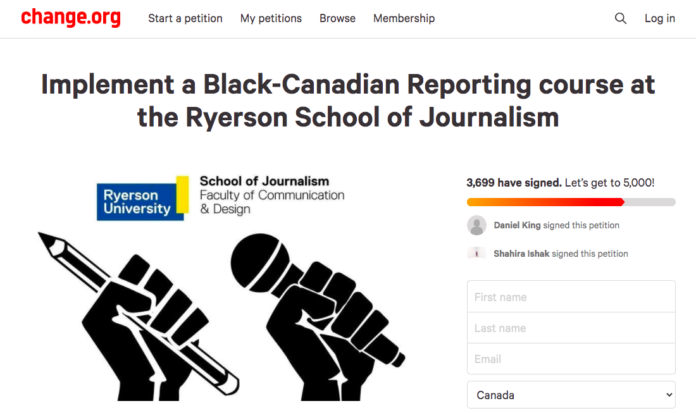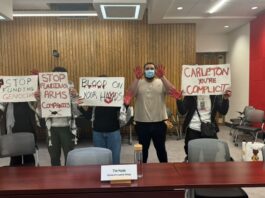This fall, Ryerson’s School of Journalism will offer a new course, “Reporting on Race: The Black community in the media” in response to a petition created by four graduating students.
Recent alumnae Rosemary Akpan, Sara Jabakhanji, Tiffany Mongu, and Breanna Xavier-Carter created the petition on June 9, demanding a Black-Canadian reporting course be implemented at Ryerson. The petition quickly garnered hundreds of signatures and currently sits at close to 4,000 signees.
The petition cited a 2010 study from Ryerson, which outlined the vast underrepresentation of visible minorities in the Canadian media industry.
The study highlights how visible minorities make up less than five per cent of media leaders and decisionmakers. It also recognizes that the media often portrays stereotypical narratives of underrepresented groups, which can “demean and marginalize” Black community members.
“My team and I were pretty much inspired by the current movement we’re witnessing right now in response to anti-Black racism and systemic racism,” Akpan said of creating the petition.
Much respect & admiration! @breanna_xcarter @mongumnews @rosiekpn @sarajabakhanji @RSJnow https://t.co/XRUWY5ZVts
— Janice Neil (she/her) (@JaniceJourno) June 18, 2020
Within the week the petition launched, the students were contacted by the Ryerson journalism department chair, Janice Neil, and a new class was implemented into the curriculum.
The course will focus on Black-Canadian history, deconstructing racial biases that are often perpetuated by the media industry, and ensuring the next generation of journalists can accurately report on matters relating to Black-Canadians.
A second call to action in the petition called for more academic recognition for Black students in the journalism school, specifically, awards and scholarships. This demand is also being met by the undergraduate program committee, associate journalism professor and committee member Sonya Fatah said.
“It means a lot to me knowing future journalists, regardless of race, will be well equipped on knowing how to properly and appropriately report on the Black community,” Akpan said. “I hope that Black journalism students will feel more seen and heard in their program, as well as feel more comfortable and welcomed in that space.”
Akpan said she is happy the school met demands quickly, but wishes changes were made years ago. She added that she hopes the elective course becomes mandatory for students in the journalism program in the future.
Incoming journalism students can now thank Ryerson alumnae, Rosemary Akpan, @breanna_xcarter @mongumnews & @sarajabakhanji for the newest addition to the school's curriculum: "Reporting on race: The Black community in the media." Well done! https://t.co/hCMXtTRGd4
— Toronto Metropolitan University Alumni (@alumnitmu) June 25, 2020
Fatah agreed the implementation of the course was “a long time coming.” She said she hopes in the future it will be made available to more journalism students than its current class capacity of 30.
“This is just one piece of the larger puzzle,” Fatah said. “It’s clear that having one course is not the solution to a very large, systemic problem that affects not just media organizations, but also journalism schools.”
Fatah emphasized how journalism school should not only be about learning the skills required for hireability, but also experimenting with new ways to do journalism.
“The next generation of journalists will enter the field with much more to contribute than just replicating a system that already exists,” she explained.
Fatah added she believes this course is a “stepping stone” for future plans at Ryerson, in terms of improving the student experience and curriculum. This means looking at representation within the faculty and among students, and noting what exposure students have to a range of topics and perspectives, she said.
This petition from @RSJnow students asking for a Black Canadian reporting cals can also spark an overdue conversation on this issue
https://t.co/eQVoXZV7Be— Canadian Association of Journalists (@caj) June 11, 2020
Second-year journalism student, Julia Gonsalves, agreed this course could help change the future of journalism.
“We will be able to understand how to approach sensitive topics and actively listen to responses of others to make a better, more compelling, and accurate story,” she said. “We will learn how to not manipulate any narratives … and create more accurate and accountable journalism.”
Gonsalves said she believes the Black Lives Matter movement has shed a light on how biased media coverage can be.
“The media is supposed to act as a ‘watchdog,’ but that’s not always the case,” she said.
Akpan agreed that the Black community has long been unfairly represented in the media.
“We need to take a good look at how and why the media portrays the Black community the way they do,” she said. “We need to get rid of biases and negative portrayals of Black people and we need to listen and understand to efficiently report these stories too.”
Fatah said the four students who started the petition should feel proud of themselves.
“They advocated for something they identified as a weakness, and they went quite deep into developing a specific solution.”
Featured image by Jillian Piper.




